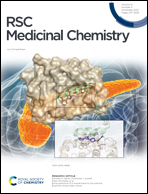Development of novel thiazolidine-2,4-dione derivatives as PPAR-γ agonists through design, synthesis, computational docking, MD simulation, and comprehensive in vitro and in vivo evaluation†
Abstract
The present study was conducted to develop new novel 2,4-thiazolidinedione derivatives (3h–3j) as peroxisome proliferator-activated receptor-γ (PPAR-γ) modulators for antidiabetic activity. The objective was to overcome the adverse effects of existing thiazolidinediones while maintaining their pharmacological benefits. The synthesized compounds were elucidated based on FT-IR, 1H-NMR, 13C-NMR, and MS techniques. Molecular docking was utilized to investigate the interaction binding modes, binding free energy, and amino acids engaged in the compounds' interactions with the target protein. Subsequently, molecular dynamics modelling was used to assess the stability of the top-docked complexes and an assay was utilized to assess the cytotoxicity of the compounds to C2C12 myoblasts. Compounds 3h–3j exhibited PPAR-γ modulatory activity and demonstrated significant hypoglycaemic effects when compared to the reference drug pioglitazone. The new compounds were evaluated for their in vivo blood glucose-lowering potential by using a dexamethasone-induced diabetic rat model. All the compounds showed a hypoglycaemic effect of 108.04 ± 4.39, 112.55 ± 6.10, and 117.48 ± 43.93, respectively, along with pioglitazone (153.93 ± 4.61) compared to the diabetic control. Additionally, all the compounds significantly reduced AST and ALT levels and did not cause liver damage.



 Please wait while we load your content...
Please wait while we load your content...